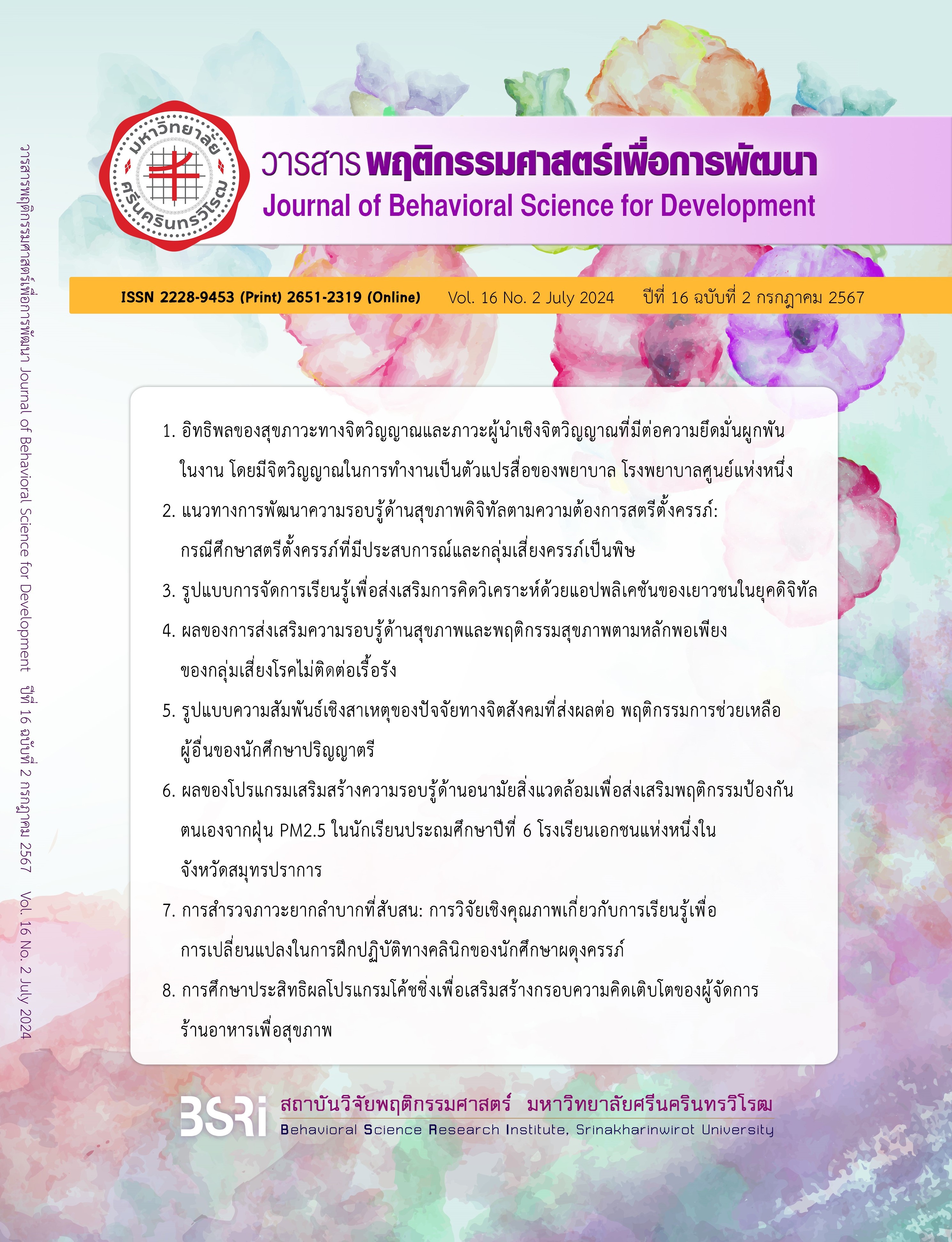Guidelines For Development Digital Health Literacy Based on Pregnancy Women: A Case Study of Pregnant Women with Experience and High-Risk Pregnancy Groups
Keywords:
Development digital health literacy, pregnant women, risk for preeclampsiaAbstract
The study aimed to 1) understand the behaviors of preventing preeclampsia and promoting digital health literacy and 2) identify obstacles, needs, and strategies for designing a program to enhance digital health literacy for preeclampsia prevention. Interviews were conducted with eight primary informants: three pregnant women with preeclampsia and five pregnant women at risk of preeclampsia. Secondary informants included three husbands caring for their wives with or at risk of preeclampsia and four nurses. Content analysis revealed that digital health literacy is defined as using electronic devices to search for health information. The behaviors to prevent preeclampsia are actions taken to avoid its occurrence. Problems for preeclampsia prevention 1) limited access to information sources, 2) lack of self-management, 3) Insufficient support or assistance4) negative attitudes, and 5) inconsistency in following medical advice. The essential needs identified are 1) technology utilization skills, 2) information searching skills, 3) media literacy skills, 4) information discernment skills, 5) self-management skills, and 6) knowledge about preeclampsia. Approaches to enhance digital health literacy include 1) active learning, 2) providing support and assistance, and 3) holistic learning that encompasses knowledge, skills, and attitudes. The findings provide a foundation for designing a program to boost digital health literacy for preeclampsia prevention.
References
Ajzen, I., & Fishbein, M. (1980). Understanding attitudes and predicting social behavior. Prentice-Hall.
American College of Obstetricians and Gynecologists. (2019). Clinical management guidelines for obstetrician-gynecologists [Electronic version]. ACOG Practice Bulletin, 133(1), 1-25.
Bandura, A. (1989). Social cognitive theory. Annals of Child Development, 6, 1-60.
Boonyakiat, S., & Junyam, P. (2017). Self-care behavior of nutrition among pregnant women at prenatal care clinic of Chaopaya Apaipubejhr Hospital. Prachinburi province, 34(4), 270-280. [in Thai]
Clark, D. (2015). Bloom's taxonomy: The psychomotor domain. http://www.nwlink.com/~donclark/hrd/Bloom/psychomotor_domain.html
Chiangkhong, C., & Intarakamhang, U. (2018). Self-directed learning program utilizing simulations, collaborative learning, and digital media for enhancing health literacy among pregnant women in Thailand. Asia-Pacific Journal of Public Health, 30(5), 456-468. https://doi.org/10.1177/1010539518792503 [in Thai]
Dheva-Aksorn, W., & Intarakamhang, U. (2023). Development of a digital health literacy program focusing on online activities to enhance competencies, knowledge, and attitudes towards practice among pregnant women. Journal of Health Literacy Research & Practice, 7(2), 45-58. https://doi.org/10.1177/23888743231027921 [in Thai]
Geboers, B., de Winter, A. F., Luten, K. A., Jansen, C. J., & Reijneveld, S. A. (2014). The association of health literacy with physical activity and nutritional behavior in older adults, and its social cognitive mediators. Journal of Health Communication, 19(2), 61-76.
Geboers, B., Reijneveld, S. A., Koot, J. A. R., & de Winter, A. F. (2018). Moving towards a comprehensive approach for health literacy interventions: The development of a health literacy intervention model. International Journal of Environmental Research and Public Health, 15(6), 1268.
Jaturongkachock, K., Intarasan, T., & Plodpluang, U. (2023). The development of health literacy model for pregnant women at risk of gestational diabetes mellitus in Banpong Hospital. Region 4-5 Medical Journal, 42, 431-444. [in Thai]
Miles, M. B., & Huberman, A. M. (1994). Qualitative data analysis: An expanded source. https://vivauniversity.files.wordpress.com/2013/11/milesandhuberman1994.pdf
Lahti-Pulkkinen, M., Girchenko, P., Tuovinen, S., Sammallahti, S., Reynolds, R., Lahti, J., Heinonen, K., Lipsanen, J., Hamalainen, E., Villa, P. M., Kajantie, E., Laivuori, H., & Raikkonen, K. (2020). Maternal hypertensive pregnancy disorders and mental disorders in children. Hypertension. https://doi.org/10.1161/HYPERTENSIONAHA.119.14140
Podhisita, C. (2019). Qualitative research. Amarin Printing & Publishing.
Rasouli, M., Pourheidari, M., & Gardesh, Z. H. (2019). Effect of self-care before and during pregnancy to prevention and control preeclampsia in high-risk women. International Journal of Preventive Medicine, 10.
Sørensen, K., Van den Broucke, S., Fullam, J., Doyle, G., Pelikan, J., Slonska, Z., & Brand, H. (2012). Health literacy and public health: A systematic review and integration of definitions and models. BMC Public Health, 12(1), 1-13.
Sørensen, K., & Brand, H. (2013). Health literacy lost in translations: Introducing the European health literacy glossary. Health Promotion International. https://academic.oup.com/heapro/article/28/4/575/664558
Strategy and Planning Division. (2019). Public health statistics A.D. 2018. http://bps.moph.go.th /new_bps/sites/default/files/statistic%2061.pdf [in Thai]
Wolf, M. S., Davis, T. C., Curtis, L. M., Webb, J. A., Bailey, S. C., & Shrank, W. H. (2011). Effect of standardized, patient-centered label instructions to improve comprehension of prescription drug use. Medical Care, 49(1), 96–100.
World Health Organization. (2019). Trends in maternal mortality 2000 to 2017. https://www.who.int/news-room/fact-sheets/detail/maternal-mortality
Youssef, G. S. (2019). Hypertension in pregnancy. European Society of Cardiology, 22(17). https://www.escardio.org/Journals/E-Journal-of-Cardiology-Practice/Volume-17/hypertension-in-pregnancy
Downloads
Published
How to Cite
Issue
Section
License
Copyright (c) 2024 Journal of Behavioral Science for Development

This work is licensed under a Creative Commons Attribution-NonCommercial-NoDerivatives 4.0 International License.




